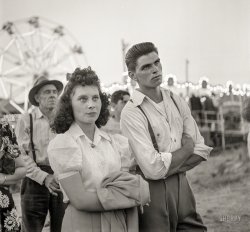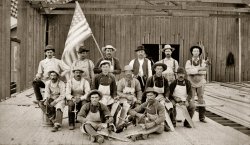
MAY CONTAIN NUTS

Search Shorpy
SHORPY ART

Framed or unframed, desk size to sofa size, printed by us in Arizona and Alabama since 2007. Explore now.
Join and Share
Ad-Free Shorpy
Shorpy is funded by you. Patreon contributors get an ad-free experience.
Learn more.

Recent comments
- Freeze Frame
- Texas Flyer wanted
- Just a Year Too Soon
- WWII -- Replacing men with women at the railroad crossing.
- Yes, Icing
- You kids drive me nuts!
- NOT An Easy Job
- I wonder
- Just add window boxes
- Icing Platform?
- Indiana Harbor Belt abides
- Freezing haze
- Corrections (for those who care)
- C&NW at Nelson
- Fallen Flags
- A dangerous job made worse
- Water Stop
- Passenger trains have right of way over freights?
- Coal
- Never ceases to amaze me.
- Still chuggin' (in model form)
- Great shot
- Westerly Breeze
- For the men, a trapeze
- Tickled
- Sense of loneliness ...
- 2 cents
- Charm City
- What an Outrage
- Brighton Park
Member Photos
The Shorpy
Print Emporium
Print Emporium
Search Shorpy
Search results -- 30 results per page
- Dead Ox Express: 1939
- October 1939. Malheur County, Oregon. "Siphon, the world's longest, which carries water five miles to Dead Ox ... Posted by Dave - 07/25/2012 - 6:56pm -

- Baker Bikers: 1941
- ... July 1941. "Motorcycle racers, Fourth of July, Vale, Oregon." Members of the Baker Motorcycle Club, last seen here . 35mm acetate ... Posted by Dave - 09/21/2020 - 11:39am -
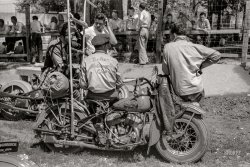
- Big Bruvver: 1941
- ... at the FSA migratory farm labor camp mobile unit. Athena, Oregon." Photo by Russell Lee for the Farm Security Administration. View full ... Posted by Dave - 05/20/2019 - 8:09pm -
![Big Bruvver: 1941 July 1941. "Children outside tent home at the FSA migratory farm labor camp mobile unit. Athena, Oregon." Photo by Russell Lee for the Farm Security Administration. View full size.
Simple pleasures -- few comfortsNo hot and cold running water; no indoor plumbing; difficult to prepare warm meals; no privacy. Toys were a luxury ...
[The camp had stoves, running water, a laundry, hot showers, a swimming pool and at least one bicycle. Also a boxing ring. - Dave]
Grapes of Wrath sceneWith all the aforementioned amenities, all that's is lacking is a lawnmower or a few goats for mowing duties.
CringeThis brings back vivid memories of the times I rode barefoot and ended up with bloody toes.
Be it ever so humble ...That bicycle is virtually new, so someone was thinking of the children and perhaps some double-duty fun.
(The Gallery, Bicycles, Kids, Russell Lee)](https://www.shorpy.com/files/images/SHORPY-8c01860a.thumbnail.jpg)
- The Vacationist: 1942
- July 1942. "Oakridge, Oregon. Vacationist." Early version of the Family Campster. Medium format ... Posted by Dave - 10/30/2020 - 12:49am -
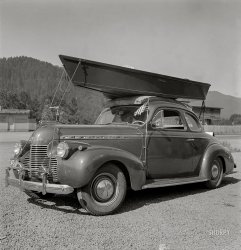
- Noogie Knights: 1941
- ... July 1941. "Roughhousing at Fourth of July picnic, Vale, Oregon." Mess with the boys of the Baker Motorcycle Club at your peril. 35mm ... Posted by Dave - 09/14/2020 - 7:31am -
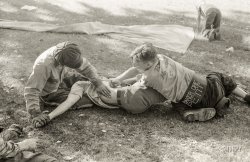
- An Essential Part: 1939
- ... Disposes of sawdust and waste. Near Klamath Falls, Oregon." Photo by Dorothea Lange. View full size.
Usually wigwam ... Posted by Dave - 02/20/2019 - 7:05pm -
![An Essential Part: 1939 August 1939. "Pelican Bay Lumber Company. The burner is as characteristic of the Northwest landscape as grain elevators are to the Plains. There are many types of variations. It is an essential part of the sawmill. Disposes of sawdust and waste. Near Klamath Falls, Oregon." Photo by Dorothea Lange. View full size.
Usually wigwam shaped.Most of these waste burners, at least in the Northwest, had flared sides (Google "wigwam burner.") Many of these rusty relics are still in place, although no longer used for reasons of air pollution. In addition, the scraps and sawdust from a lumber mill are no longer considered to be waste. They make up useful biomass which can be used for construction materials, mulch, fuel, etc.
This impressive erection must have been an unusual case.
[In other words, not shaped like a shuttlecock. - Dave]
NSFWIs this the new Shorpy?
Beehive BurnersIn British Columbia these were called beehive burners, since most of them had that shape. The last one I saw in operation was in the 1990s at a lumber mill in Canal Flats, near Cranbrook, B.C. This was at night, and the lower portions of the burner were glowing red hot, and sparks and cinders were flying out of the screen at the top into the dark sky. It was quite dramatic. The mill is still there, but the beehive burner is long gone. The City of New Westminster, near Vancouver, interviewed a worker who maintained a beehive burner here, and CBC television news covered an artist who painted them here.
There's Gold In Them There Sawdust Now.When I worked for Georgia Pacific the sawdust was collected as logs and plywood panels were cut to size and sucked outside to a waiting freight car to be sent someplace where there must have been a deficit of sawdust.
Unused wood, bark and damaged panels was also processed in a grinder and reduced to splinters before being sent off. There was very little waste generated.
I always imagined the sawdust was sent to Pringles and combined with potato mush to be made into Pine Cone Delight Potato Chips.
Off The Grid A sawdust burner is part of the plot in the C. J. Box novel "The Disappeared".
(The Gallery, Dorothea Lange, Industry & Public Works)](https://www.shorpy.com/files/images/SHORPY-8b34541a.thumbnail.jpg)
- Vroom With a View: 1928
- ... and after a few days rented a car to drive up to Oregon. I picked the car up near this very street, and when I came out of the ... Posted by Dave - 02/09/2016 - 5:42pm -
![Vroom With a View: 1928 San Francisco circa 1928. "DeSoto sedan cresting hill." Last seen here a year ago, making steady progress up Webster Street toward points unknown. 5x7 inch glass negative by automotive impresario Christopher Helin. View full size.
Bullitt: the PrequelI presume it's being chased by a 1928 Ford, driven by Steve McQueen's father.
Scary drivingI flew into San Francisco once for a convention and after a few days rented a car to drive up to Oregon. I picked the car up near this very street, and when I came out of the garage I was actually afraid I'd slide backward if I stopped. I'm sure you get used to it, but for a flatlander, the first time on those hills is a very scary experience.
Love the old car photosbut I can't help but wonder, how were the cars transported in the early days. Flatbed? Inside box cars? In your archives do you have any photos of the actual loading and unloading of the cars that make it to San Francisco where, apparently, all car makers wanted their new models photographed.
Re: Scary DrivingEven for Bay Area drivers, it can still be "exciting" at times! For extra fun, try navigating through SF hill streets with a manual transmission after the clutch throwout mechanism failed part way through the trip (my Datsun 510 in the early 70's). Shifting without the clutch is tricky, but learnable. Stopping at an intersection and starting out again is insane!
[My baptism of fire was in the 70s in a Datsun 1200 on Gough which, if you were brave and wanted to avoid congested Van Ness, you took to catch the Central Freeway to continue south on 101. You tried to time it to arrive first at the stop signs so you could pull up over the hump rather than being stuck on the incline. -tterrace]
Exactly, TT! And pre-280, that was the only reasonable way through the City, north- or south-bound. Starting the engine in gear made that placement a requirement...
(The Gallery, Cars, Trucks, Buses, Chris Helin, San Francisco)](https://www.shorpy.com/files/images/SHORPY-893.thumbnail.jpg)
- Grandmother: 1939
- ... borrower. Willow Creek area. Malheur County, Oregon." Medium-format nitrate negative by Dorothea Lange for the FSA. View ... Posted by Dave - 07/30/2012 - 2:43pm -
![Grandmother: 1939 October 1939. "Soper grandmother, who lives with family. Farm Security Administration borrower. Willow Creek area. Malheur County, Oregon." Medium-format nitrate negative by Dorothea Lange for the FSA. View full size.
Huh?Did they mean super grandmother? If not, what is a soper grandmother?
[She's a member of the Soper family. - Dave]
I live in this areaMy grandparents moved here around that time. I will see if they recognize her. Interesting.
(The Gallery, Dorothea Lange, Portraits)](https://www.shorpy.com/files/images/8b35079u.thumbnail.jpg)
- Farm Dad: 1939
- ... develop the farm and do not go to school. Malheur County, Oregon." Photo by Dorothea Lange for the Farm Security Administration. View ... Posted by Dave - 06/21/2020 - 12:18pm -
![Farm Dad: 1939 October 1939. "George Cleaver, new farmer on 177 acres, has five boys. The three older boys, ages 12, 16 and 18, are needed at home to develop the farm and do not go to school. Malheur County, Oregon." Photo by Dorothea Lange for the Farm Security Administration. View full size.
With 7 you get eggrollPer the 1940 Census, the family was a bit larger. There was also a first born daughter, Georgia Ruth Cleaver Elliot (born 1917), who evidently didn't move west with the family, remaining in Missouri.
Large families were popular with the Cleavers. The eldest son, Lester (1918-1998), also farmed. As of 2016 when his widow Virginia died, there was a family left behind of 10 children, 38 grandchildren, 100 great grandchildren and 18 great great grandchildren.
School DaysI never forget back when I was in grammer school back in the 50s students who lived on a farm were excused from school during the fall to help with the crops which were an all hand evolution before all the big mechanical harvesters. Don't try that now.
["Grammer" school! - Dave]
Body language doesn't lieAnd theirs, along with their relaxed and happy facial expressions, bespeaks a close relationship. Maybe money was tight, but they were successful in ways that we could use more of today.
(The Gallery, Agriculture, Dorothea Lange, Kids)](https://www.shorpy.com/files/images/SHORPY-8b38823a_0.thumbnail.jpg)
- Before Television
- Found negative in a dumpster in Portland, Oregon. Unknown photographer. View full size.
The world at your ... Posted by William - 06/26/2009 - 12:33pm -
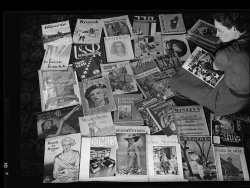
- New Train: 1911
- ... Humboldt County, California. Taken in Samoa, 1911ish. Oregon Eureka Railroad owned by Hammond Lumber Co. Photographer unknown. View ... Posted by kevhum - 09/23/2011 - 12:02am -
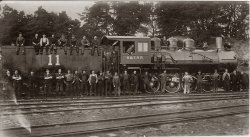
- Too Much Excitement: 1941
- 1941. At the picnic grounds in Vale, Oregon. "Interlude, after watching the Fourth of July parade." View full ... Posted by Dave - 01/09/2008 - 9:14pm -
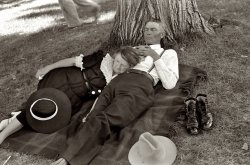
- Potato Polo: 1941
- ... in potato race at the Fourth of July celebration in Vale, Oregon." Photo by Russell Lee for the Farm Security Administration. View full ... Posted by Dave - 07/13/2021 - 2:45pm -
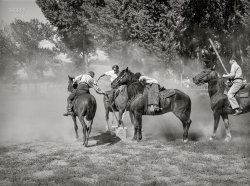
- Armada Americana: 1898
- ... is forward of Brooklyn on the far right and BB3 USS Oregon forward of Indiana.
Tumblehome The exaggerated bulge at the ... Posted by Dave - 04/16/2018 - 8:03pm -
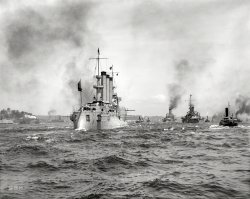
- Centrifugal Fourth: 1941
- ... which was part of the Fourth of July celebration at Vale, Oregon." Medium format negative by Russell Lee. View full size.
... Posted by Dave - 03/11/2018 - 4:52pm -
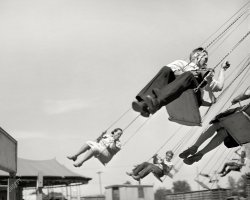
- Mrs. Wardlaw: 1939
- ... Society of Friends church. Dead Ox Flat, Malheur County, Oregon. View full size. Photograph by Dorothea Lange.
This is my Great ... Posted by Dave - 09/08/2011 - 5:16pm -
![Mrs. Wardlaw: 1939 October 1939. Mrs. Wardlow [Wardlaw] at the Society of Friends church. Dead Ox Flat, Malheur County, Oregon. View full size. Photograph by Dorothea Lange.
This is my Great GrandmotherThis is a picture of my great-grandmother Eva Wardlaw. They misspelled are name as Wardlow. She was born in August 1891 and died in 1963. She had four children. To date she has over 100 descendants.
Agnes Lorraine (Ruda) BorbaHi,
I was doing family research when I saw a Agnes Lorraine (Ruda) Borba with connection to a Scott Wardlow genealogy.
If you are the right person please email me. I have alot concerning Agnes.
She is on my Borba line.
Email me at marcioborba_genea@yahoo.com
Happy Holidays
(The Gallery, Dorothea Lange, Rural America)](https://www.shorpy.com/files/images/8b35187u.thumbnail.jpg)
- Meet Me at Multnomah: 1918
- Multnomah Falls, Oregon, circa 1918. "Kissel military Highway Scout Kar." The camouflage-painted ... Posted by Dave - 03/03/2015 - 9:28am -
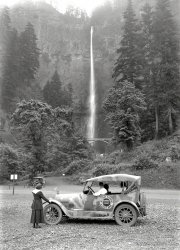
- Bean Pickers: 1939
- August 1939. Marion County, Oregon, near West Stayton. Children in large private bean pickers' camp. The ... Posted by Dave - 09/07/2011 - 9:55pm -
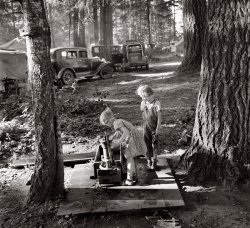
- Fourth of July, 1887
- ... bred and trained Belgian draft horses for logging work in Oregon.
Hand tools Obviously someone deliberately choreographed this so ... Posted by willc - 07/26/2009 - 8:51am -
- Skunk Cabbage Acres: 1936
- ... cabbage, ferns and alders keep this farmer in the north Oregon hills hard at work as he attempts to clear an abandoned homestead. ... Posted by Dave - 07/30/2012 - 10:50am -
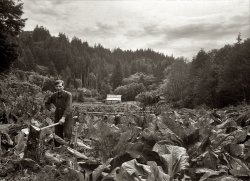
- Welcome, Wagon: 1919
- ... in October, 1919, but the couple stated in the Roseburg [Oregon] Review, on October 3rd, that they had been on the road for eight months ... Posted by Dave - 08/05/2016 - 9:57pm -
![Welcome, Wagon: 1919 San Francisco circa 1919. "Bus" is all it says on the sleeve of this 5x7 glass negative showing a motor home on an Atterbury truck chassis. In the Firestone display window, it's beginning to look a little like New Year's. View full size.
Mystery hardwareI can usually identify most components of early automobiles, but those vertical cylinders which appear to be attached to the forward end of the front springs have me baffled.
Some sort of primordial air suspension or shock absorber??
Shock absorbers, probably by Gruss, as seen and commented on in this photo. -tterrace]
Cross-CountryAtterbury trucks were made in Buffalo, New York.
Automobile Row againEarle C. Anthony's REO and Dort dealership was at 1400 Van Ness Ave., with Firestone Tire & Rubber (F.C. Flickinger, manager) next door at 1414.
San Francisco Planning Commission on 1400 Van Ness: "This is a fine restrained Classical Revival auto showroom with a rusticated base and Corinthian pilasters. The bay and pilaster width relate to the width of the street, with the Van Ness facade having a larger scale than the Bush facade. Because of the building’s corner location it would be difficult to alter or add to without significantly harming its integrity; therefore the building should remain intact."
The PalaceAlmost certainly, the gentleman standing just to the right of the driver's door is Arthur M. Neal (1869 - 1938) who built this traveling home for himself and his wife Fannie I. Neal (1871 - 1965). Having been the proprietor of the Hotel Arthur (1911-1912) and the Hotel Yale (1913 - 1919) in San Diego, he knew what accommodations were needed when traveling away from home. They nicknamed their vehicle "The Palace." The San Diego commercial automobile body firm of Klersy & Caldwell provided assistance with the build of the motorhome which was painted brown. Based on California vehicle registrations, the Atterbury was used by the New Southern Hotel as a bus prior to the Neal's ownership. It is likely a Model D built circa 1914.
Newspaper articles start appearing with photos of their mobile home in October, 1919, but the couple stated in the Roseburg [Oregon] Review, on October 3rd, that they had been on the road for eight months already. All of the earliest newspaper photos of their caravan do not show the Gruss shock absorbers installed, leading me to wonder if perhaps the Firestone dealer installed the devices for the Neal's. After visiting San Francisco their intent was to head east for a year.
The article below, from the magazine "Sunset," published in June 1920, describes more about their vehicle and the Neal's extended travels. This article is the last published piece I found about their excursion. The pair returned to San Diego later in 1920 or early 1921 where they became the managers of an apartment building at 1313 24th Street until Arthur Neal passed away in 1938. Fannie Neal continued residing there until just after WWII, but, even after leaving this apartment, she remained in San Diego for the rest of her life. She died at the age of 93 in 1965.
(The Gallery, Cars, Trucks, Buses, Chris Helin, San Francisco)](https://www.shorpy.com/files/images/SHORPY-1013.thumbnail.jpg)
- High Tension: 1941
- ... tug-of-war at the Fourth of July celebration at Vale, Oregon." Photo by Russell Lee for the Farm Security Administration. View full ... Posted by Dave - 10/19/2018 - 1:38pm -
![High Tension: 1941 July 1941. "Kids' tug-of-war at the Fourth of July celebration at Vale, Oregon." Photo by Russell Lee for the Farm Security Administration. View full size.
Noise Payette Lumber Company Vale is close to Idaho where we find said lumber company.
[Is Noise near Boise? - Dave]
Stupid spell check;)
Boys Will Be BoysBoise will be Noise.
Still a big dealThe high fence (with barbed wire at the top) suggests this occurred in Vale's rodeo arena. For over a century Vale has hosted a four-day rodeo that concludes on July 4, complete with parades, concessions and races.
It just occurred to me:In a mêlée or a scrum, don't mix barefoot/stocking with boots. That could hurt the footwearwise challenged participants.
(The Gallery, July 4, Kids, Russell Lee, Small Towns, Sports)](https://www.shorpy.com/files/images/SHORPY-8c01676a1.thumbnail.jpg)
- A Billion Beets: 1939
- ... River. Shows beet dump, beet pile. Nyssa, Malheur County, Oregon." Medium format negative by Dorothea Lange for the Farm Security ... Posted by Dave - 01/31/2018 - 6:30pm -
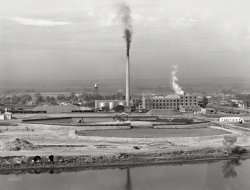
- Meet the Tenants: 1906
- ... September 2011, I was honored to be part of the Portland (Oregon) Gay Men's Chorus, who was invited to sing a concert at the Cathedral of ... Posted by Dave - 10/26/2014 - 10:11am -
![Meet the Tenants: 1906 Manhattan circa 1906. "Trinity Building and Broadway, New York." Along with Trinity Church cemetery and its Independence Memorial Spire. 8x10 inch dry plate glass negative, Detroit Publishing Company. View full size.
The dearly departedThat's a sizable cemetery of the Cathedral of St. John the Divine nestled next to skyscrapers in 1906. Is it still there?
[You are very lost. Try reading the caption! - Dave]
Powerful memories, 105 years laterIn September 2011, I was honored to be part of the Portland (Oregon) Gay Men's Chorus, who was invited to sing a concert at the Cathedral of St. John the Divine to help commemorate the tenth anniversary of the September 11th attacks.
Spending a few days in New York at the time of the anniversary was a memorable and moving trip. Seeing the place where the towers once stood, hearing the stories of survivors and how they escaped and how many of their coworkers didn't make it out, looking at the beautiful new Freedom Tower being built are things that will stay with me for a long time.
One very simple and powerful tribute to the victims of that horrible day was done on the fence of Trinity Church. People were invited to write memories, prayers, and messages on simple white ribbons and tie them to the fence around the cemetery. There were thousands of them, blowing gently in the breeze, a silent reminder of all who were lost. There wasn't a dry eye in our group as we passed them.
One cementary on very expensive real estate.The first thing I thought of on seeing this image was how valuable this small piece of real life history was. Of course, ask 10 people and they would assess its value differently. Donald Trump would love to get his grubby fingers on this one.
Also the work demolishing the building is of interest. One can easily think that the present appetite for destroying (to improve?) is a modern phenomenon.
[A cheaper alternative: the ready-mix cementary. - Dave]
(The Gallery, DPC, NYC)](https://www.shorpy.com/files/images/SHORPY-4a13109a.thumbnail.jpg)
- See Other Side: 1975
- ... photo, same trip, same guys: my friend, my brother, me. In Oregon, near some big mountain or other. Trying to remember the name... don't ... Posted by tterrace - 04/06/2016 - 5:29pm -
![See Other Side: 1975 A companion to my Crater Lake photo, same trip, same guys: my friend, my brother, me. In Oregon, near some big mountain or other. Trying to remember the name... don't tell me, it'll come to me... View full size.
Aw manWhat's on the other side?
Diamond Peak 2016Just drove by and took this photo. One mile west of Willamette pass summit on highway 58. Lot of snow this year!
[Thank you! Just this week when I posted my photo on my Facebook page I wanted to include the exact spot, but once I finally found it the Google street view image turned out to be horrible. - tterrace]
(ShorpyBlog, Member Gallery, Travel & Vacation, tterrapix)](https://www.shorpy.com/files/images/diamondpeak.thumbnail.jpg)
- Up a Tree: 1942
- July 1942. Klamath Falls, Oregon. "Boys in city park on a Sunday afternoon." Photo by Russell Lee for the ... Posted by Dave - 03/18/2016 - 9:21pm -
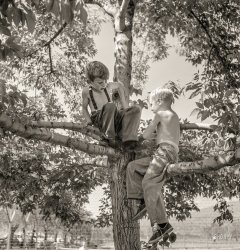
- Red Robin: 1941
- ... the Fourth of July" at the Red Robin Coffee Shop in Vale, Oregon. The year was 1941. Can we stay just a little longer? View full size. ... Posted by Dave - 01/08/2008 - 11:07am -
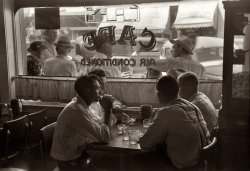
- Picnic in the Park: 1942
- July 1942. "Klamath Falls, Oregon. Picnickers in city park." Medium format nitrate negative by Russell Lee ... Posted by Dave - 03/09/2016 - 9:57pm -
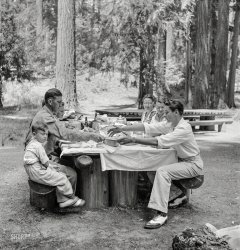
- House Call: 1939
- ... 1939. Farm Security Administration camp unit at Merrill, Oregon. The camp nurse introduces doctor to mother of sick baby. View full ... Posted by Dave - 12/08/2007 - 4:35pm -
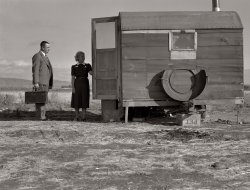
- Serious Fun: 1942
- July 1942. Klamath Falls, Oregon. "At the sideshow of the circus." Step right up, folks, and SEE the ... Posted by Dave - 03/13/2016 - 8:51pm -
